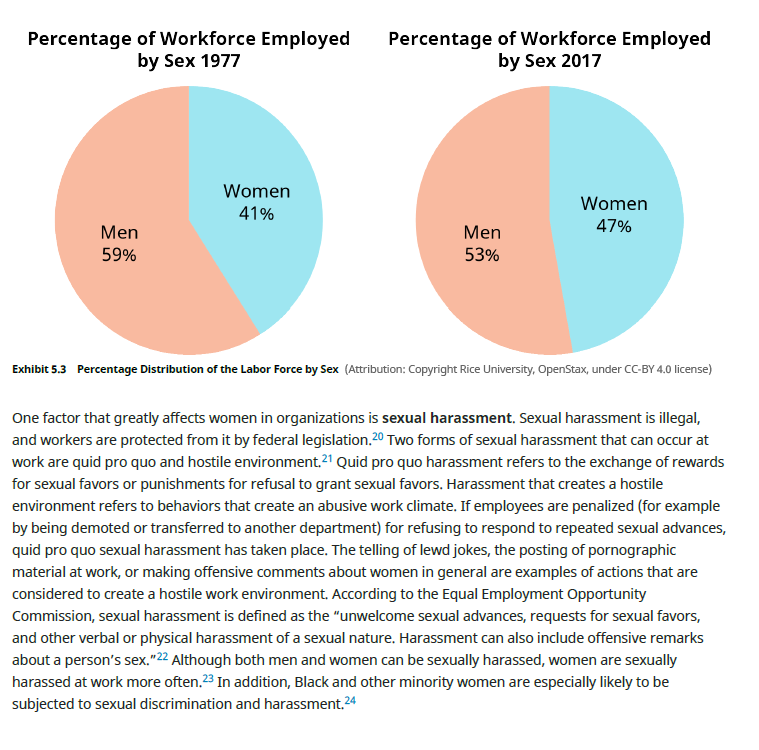Answered step by step
Verified Expert Solution
Question
1 Approved Answer
Are some forms of discriminatory hiring impossible to avoid? What can a candidate do to avoid being a victim of these kinds of practices?




Are some forms of discriminatory hiring impossible to avoid? What can a candidate do to avoid being a victim of these kinds of practices? If you were a manager, what steps could you take to ensure a fairer hiring process? 5.2 Diversity and the Workforce 2. How diverse is the workforce? In 1997, researchers estimated that by the year 2020, 14% of the workforce would be Latino, 11% Black, and 6% Asian,10 Because of an increase in the number of racial minorities entering the workforce over the past 20 years, most of those projections have been surpassed as of 2016, with a workforce composition of 17% Hispanic or Latino of any race, followed by 12% Black and 6% Asian (see Exhibit 5.2). American Indians, Alaska Natives, Native Hawaiians, and Other Pacific Islanders together made up a little over 1% of the labor force, while people of two or more races made up about 2% of the labor force. Women constitute approximately 47% of the workforce compared to approximately 53% for men, 2 and the average age of individuals participating in the labor force has also increased because more employees retire at a later age. 3 Although Whites still predominantly make up the workforce with a 78% share, 4 the U.S. workforce is becoming increasingly more diverse, a trend that presents both opportunities and challenges. These demographic shifts in the labor market affect the workforce in a number of ways due to an increasing variety of workers who differ by sex, race, age, sexual orientation, disability status, and immigrant status. Percent Distribution 90% 80 70 60 578 20 50 40 30 10 0 Percentage Distribution of the Labor Force by Race 1994 2014 2004 Year Projections 1994-2024 2024 -All other groups -White non-Hispanic Black Asian Hispanic origin Exhibit 5.2 Percentage distribution of the labor force by race (Attribution: Copyright Rice University, OpenStax, under CC-BY 4.0 license) Gender Increasingly more women are entering the workforce. 15 Compared to 59% in 1977, the labor force participation rate for men is now approximately 53% and is expected to decrease through 2024 to 52%.16 As the labor force participation rate decreases for men, the labor force growth rate for women will be faster. Their percentage of the workforce has steadily risen, as can be seen in Exhibit 5.3, which compares the percentage of the workforce by gender in 1977 to 2017.17 Although more women are entering the labor force and earning bachelor's degrees at a higher rate than men, 18 women still face a number of challenges at work. The lack of advancement opportunities awarded to qualified women is an example of a major challenge that women face called the glass ceiling, 19 which is an invisible barrier based on the prejudicial beliefs that underlie organizational decisions that prevent women from moving beyond certain levels within a company. Additionally, in organizations in which the upper-level managers and decision makers are predominantly men, women are less likely to find mentors, which are instrumental for networking and learning about career opportunities. Organizations can mitigate this challenge by providing mentors for all new employees. Such a policy would help create a more equal playing field for all employees as they learn to orient themselves and navigate within the organization. Percentage of Workforce Employed by Sex 1977 Men 59% Women 41% Percentage of Workforce Employed by Sex 2017 Men 53% Women 47% Exhibit 5.3 Percentage Distribution of the Labor Force by Sex (Attribution: Copyright Rice University, OpenStax, under CC-BY 4.0 license) One factor that greatly affects women in organizations is sexual harassment. Sexual harassment is illegal, and workers are protected from it by federal legislation.20 Two forms of sexual harassment that can occur at work are quid pro quo and hostile environment,21 Quid pro quo harassment refers to the exchange of rewards for sexual favors or punishments for refusal to grant sexual favors. Harassment that creates a hostile environment refers to behaviors that create an abusive work climate. If employees are penalized (for example by being demoted or transferred to another department) for refusing to respond to repeated sexual advances, quid pro quo sexual harassment has taken place. The telling of lewd jokes, the posting of pornographic material at work, or making offensive comments about women in general are examples of actions that are considered to create a hostile work environment. According to the Equal Employment Opportunity Commission, sexual harassment is defined as the "unwelcome sexual advances, requests for sexual favors, and other verbal or physical harassment of a sexual nature. Harassment can also include offensive remarks about a person's sex."22 Although both men and women can be sexually harassed, women are sexually harassed at work more often. 23 In addition, Black and other minority women are especially likely to be subjected to sexual discrimination and harassment, 24
Step by Step Solution
There are 3 Steps involved in it
Step: 1
Discriminatory hiring practices can unfortunately persist in various forms despite legal and social efforts to eliminate them Some forms of discriminatory hiring practices that may be challenging to a...
Get Instant Access to Expert-Tailored Solutions
See step-by-step solutions with expert insights and AI powered tools for academic success
Step: 2

Step: 3

Ace Your Homework with AI
Get the answers you need in no time with our AI-driven, step-by-step assistance
Get Started


